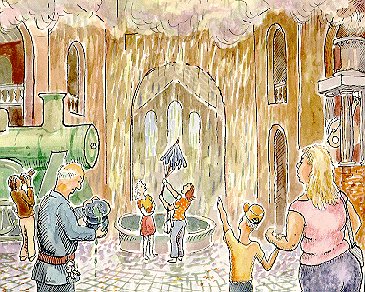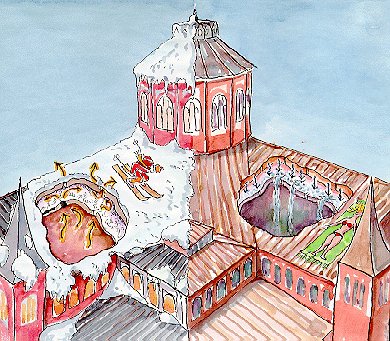
 |
Condensation in the walls of humidified buildings - 2 |
The wisdom of installing a barrier to air flow becomes even more doubtful when restoring an old building.
 This picture is based on an eyewitness account of the scene within the rotunda of the Arts and Industries Museum in Washington D.C on a warm, clear, spring morning. The clouds dispersed, metaphorically at least, when an analysis of the liquid on the guard's hat revealed a cocktail of exotic ions: borate, ammonium, potassium and phosphate; all constituents of fireproofing treatment of plywood. For help in the subsequent investigation I thank my colleague on several such forensic adventures, David Erhardt of the Conservation Analytical Laboratory of the Smithsonian Institution.
This picture is based on an eyewitness account of the scene within the rotunda of the Arts and Industries Museum in Washington D.C on a warm, clear, spring morning. The clouds dispersed, metaphorically at least, when an analysis of the liquid on the guard's hat revealed a cocktail of exotic ions: borate, ammonium, potassium and phosphate; all constituents of fireproofing treatment of plywood. For help in the subsequent investigation I thank my colleague on several such forensic adventures, David Erhardt of the Conservation Analytical Laboratory of the Smithsonian Institution.
The prefabricated roof panels are boxes made of two layers of plywood enclosing glass fibre insulation and a polyester moisture barrier.
During the winter, air penetrated from the museum into the boxes and water condensed into the cold upper plywood panel. The process was aided by the hygroscopicity of the fireproofing salts. Drying to the outside was prevented by the lead-coated copper roof. The process continued without symptoms throughout the winter, as shown on the left side of the picture below.
 On a warm spring day (the right half of the picture) bright sunlight warmed the dark lead roof to over 80C. Water evaporated from the saturated upper plywood. The vapour diffused through the insulation and condensed on the vapour barrier. The hydrophobic vapour barrier collected the water in drops on its gently sloping surface. At a critical moment two drops coalesced, collected a third and started a little stream down the surface of the polyester. The stream became a flood and cascaded through the joints in the metal ceiling to surprise the museum guests below.
On a warm spring day (the right half of the picture) bright sunlight warmed the dark lead roof to over 80C. Water evaporated from the saturated upper plywood. The vapour diffused through the insulation and condensed on the vapour barrier. The hydrophobic vapour barrier collected the water in drops on its gently sloping surface. At a critical moment two drops coalesced, collected a third and started a little stream down the surface of the polyester. The stream became a flood and cascaded through the joints in the metal ceiling to surprise the museum guests below.

This work is licensed under a Creative Commons Attribution-Noncommercial-No Derivative Works 3.0 License.